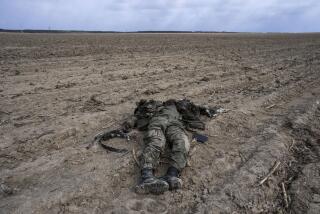Stalin Juggled Census Figures, Magazine Says
- Share via
MOSCOW — A Soviet magazine says Josef Stalin altered census figures in the 1930s, hiding millions of deaths that resulted from poor harvests and his rapid industrialization and collectivization of farming.
An article by demographer Mark Tolts in the latest edition of the weekly magazine Ogonyok was another blow to Stalin’s legacy.
Western scholars have blamed the Soviet leader’s policies for millions of deaths in the early 1930s and have said the suffering was perhaps worse than the better-known purges later in the decade.
However, the Soviets previously attributed the suffering, which was especially severe in the breadbasket regions of the northern Caucasus and the Ukraine, to a crop failure.
Ogonyok said the difficulties of the period have been covered over for decades in official history by referring to “difficulties of the period of industrialization and collectivization.”
True Size Unknown
It said the time has come to talk about what was hidden by that phrase but that the true size of the tragedy still is unknown.
It said Stalin told a party congress in 1934 that the Soviet population in 1933 was 168 million, although census officials put the figure at 165.7 million and one scientist put it as low as 158 million.
For 1937, Stalin gave a figure of 170 million, even though statistics could not confirm it, Ogonyok said. In the 1960s, the Soviet Union’s Central Statistical Administration estimated the 1937 population at 163.8 million, 6.2 million less, the magazine said.
Current Soviet reference books put the country’s population in 1917, the year the Soviets took power, at 163 million people and do not include any population figures for the 1920s or 1930s.
An estimated 20 million Soviets also died during World War II, but the population rebounded and since has grown to about 280 million.
Poor Harvest
Farmers were forced onto collective farms beginning in 1929. Ogonyok said the Ukraine and the northern Caucasus region were hit with an extremely poor harvest in 1932, just at the time when Stalin was demanding heavy requisitions of grain to sell abroad to finance his industrialization program.
“Hunger gripped first of all that part of the population of the country which normally fed it. Children suffered first. Whole families died in the villages. It is known that in order to fulfill the plan in those difficult circumstances, in many places all the grain was called for procurement, without exception,” the magazine said said.
In a speech marking the 70th anniversary of Soviet power in early November, Soviet leader Mikhail S. Gorbachev sharply criticized Stalin’s “enormous and unforgiveable crimes,” but said the policy of rapid industrial growth and collectivization of agriculture of the early 1930s was the only path the Soviet Union could have followed.
More to Read
Sign up for Essential California
The most important California stories and recommendations in your inbox every morning.
You may occasionally receive promotional content from the Los Angeles Times.












